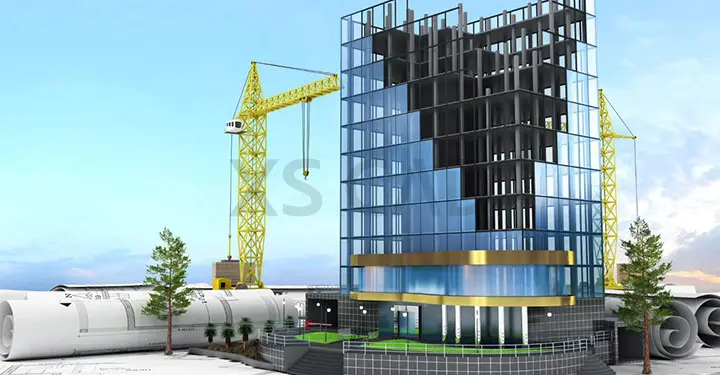Our Articles

How Structural Engineering Affects Building Services Coordination
‘It takes a village to raise a child,’ a wise African once said. Well, it takes several teams of professionals to raise a building, and like the squabbles of family members, intense but well meaning, structural engineers and building services design consultants do not always see eye to eye. Their worlds must integrate, not collide. Structural design and any changes to that design will affect MEP (M&E) or building services coordination. With the use of BIM (Building Information Modelling) and BIM MEP services, the effects can be optimised. Let’s understand how.
Firstly, what is structural engineering for a building?
Very simply, it is engineering that involves structural design and analysis for buildings that support or resist loads. Detailed knowledge and data of applied mechanics and mathematics, materials science, etc. are required to help predict how effective buildings are in supporting and resisting their own weight and those loads that are imposed on them.
Detailed design drawings, data and the details of material resistance to corrosion are mandatory elements of structural engineering. Structural design is aptly assisted today with specialist software, such as AutoCAD and Revit Structure, which can help design, draw and analyse buildings to an impressive degree of accuracy.
And then there’s MEP coordination, which is concerned with detecting and resolving clashes among architectural, structural, mechanical, electrical, plumbing and fire safety designs. A coordinated updated design is created to include all the individual trade and discipline designs which are updated themselves. The building’s fabric, structure and envelope (steel, concrete, etc.) must be harmonised with building services (mechanical, electrical and plumbing systems).
In some cases, MEP consultants create coordinated MEP drawings for the MEP contractor, who then handles fabrication and installation. The MEP (M&E) contractor must execute the detailing, spatial coordination and installation based on the coordinated drawings, which means that the MEP coordination drawings must be as near-flawless as possible.
Several revisions, perhaps even a series of them, are made before and during the coordination process. Using MEP BIM Services (Building Information Modelling), MEP contractors plan, modify design and install equipment efficiently, as BIM works on a 3D object-oriented approach and reasoning that is data driven. Yet, structural changes during the design process can upset the cart.
Structural Changes Create Challenges for Coordination
Space allocation for MEP systems during the design phase may change with unavoidable structural changes. Maintaining space for MEP systems and individual equipment presents MEP coordination challenges.
Space allocation for MEP Systems
The MEP engineer designs the right size for MEP systems and precisely plans the MEP system layout based on accurate architectural and structural models. Any changes in building structure require changes in the spaces occupied by and placement of MEP systems.
The Process
Spatial Coordination for MEP Systems
An important reason why it’s best to minimise structural changes is the effect that it has on the spatial coordination of MEP equipment and systems. Unused space is seen as directly responsible for reduced ROI. Certain MEP equipment and components are large and need to be placed accordingly. Typically, individual design teams will tussle over the space above the ceiling, fighting for every inch. This is why:
If structural changes are made to the agreed design at a later date, building services and their coordination will be significantly affected. Using BIM technology proves advantageous.
BIM Benefits for Structural Engineering
Using BIM enables a seamless construction process that integrates building services coordination and structural elements, and structural decisions should be finalised using BIM models. If the structure has to be modified or changed in any way for any reason, the building services layouts, and even perhaps material and equipment, will have to change accordingly, which means that the building services coordination must be reworked.
This is why it is imperative to make structural changes in the design phase and not on site. Structural changes during construction can prove to be costly for owners. For example, suppose there was a change to the structure that required additional beam penetrations. How would that play out?
This constant tussle between structural and building services requirements needed a white knight, and that’s when Autodesk BIM 360 Design (formerly known as Collaboration for Revit) came charging in. The design collaboration software BIM 360 Design enables real-time Revit cloud work-sharing and streamlined workflows for structural and MEP design, among other things.
Autodesk BIM 360 Design Advantages
The use of BIM 360 Design can thus help structural engineering and building services coordination integrate efficiently and results in the overall improvement of productivity, reduced rework and on-time delivery of projects.
So, if MEP design and drafting partners that offer outsourced drafting services are adept at using BIM 360 Design, they can provide high-quality mechanical CAD drafting services and electrical drafting services and can optimise the effects of structural engineering on MEP coordination.
XS CAD has valuable experience providing BIM MEP services, mechanical CAD drafting services and electrical design and drafting services for global firms. Our range of services for building services design consultants and contractors across the world include MEP drafting, electrical drafting, public health system drafting and building services coordination using BIM 360 Design.

